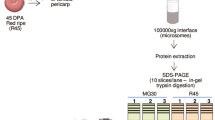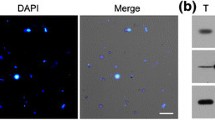Abstract
Tomato is a major crop plant and an important constituent of the human diet. Exclusive features such as bearing fleshy fruits and undergoing a phase transition from partially photosynthetic to fully heterotrophic metabolism make tomato fruit a model system for fruit development studies. Although the tomato genome has been completely sequenced, functional proteomics studies are still at their starting stage. Proteomics technologies, especially the combination of multiple approaches, provide a very powerful tool to accurately identify functional proteins and investigate certain sets of proteins in more detail. The direct binding of plant 14-3-3 proteins to their multiple target proteins modulates the functions of the latter, suggesting that these 14-3-3 proteins are directly involved in various physiological pathways. This chapter outline methods for the identification of 14-3-3 protein complexes in tomato fruit tissues. These methods include detailed protocols for protein extraction, coimmunoprecipitation, SDS-PAGE, SYPRO Ruby staining, in-gel trypsin digestion, and LC-MS/MS analysis for 14-3-3 interactomics.
Access this chapter
Tax calculation will be finalised at checkout
Purchases are for personal use only
Similar content being viewed by others
References
Tohge T, Alseekh S, Fernie AR (2014) On the regulation and function of secondary metabolism during fruit development and ripening. J Exp Bot 65:4599–4611
Shikata M, Hoshikawa K, Ariizumi T et al (2016) TOMATOMA update: phenotypic and metabolite information in the Micro-Tom mutant resource. Plant Cell Physiol 57:e11
The Tomato Genome Consortium (2012) The tomato genome sequence provides insights into fleshy fruit evolution. Nature 485:635–641
Oecking C, Jaspert N (2009) Plant 14-3-3 proteins catch up with their mammalian orthologs. Curr Opin Plant Biol 12:760–765
Chang IF, Curran A, Woolsey R et al (2009) Proteomic profiling of tandem affinity purified 14-3-3 protein complexes in Arabidopsis thaliana. Proteomics 9:2967–2985
Sato T, Maekawa S, Yasuda S et al (2009) CNI1/ATL31, a RING-type ubiquitin ligase that functions in the carbon/nitrogen response for growth phase transition in Arabidopsis seedlings. Plant J 60:852–864
Sato T, Maekawa S, Yasuda S et al (2011) Identification of 14-3-3 proteins as a target of ATL31 ubiquitin ligase, a regulator of the C/N response in Arabidopsis. Plant J 68:137–146
Yasuda S, Sato T, Maekawa S et al (2014) Phosphorylation of Arabidopsis ubiquitin ligase ATL31 is critical for plant carbon/nitrogen nutrient balance response and controls the stability of 14-3-3 proteins. J Biol Chem 289:15179–15193
Yasuda S, Aoyama S, Hasegawa Y et al (2017) Arabidopsis CBL-interacting protein kinases regulate carbon/nitrogen-nutrient response by phosphorylating ubiquitin ligase ATL31. Mol Plant 10:605–618
Lu Y, Yasuda S, Li X et al (2016) Characterization of ubiquitin ligase SlATL31 and proteomic analysis of 14-3-3 targets in tomato fruit tissue (Solanum lycopersicum L.). J Proteome 143:254–264
Acknowledgments
This work was supported by a Grant in-Aid for Scientific Research to T.S. [Nos. 15K18819 and 17K08190], by Grants in Aid for Scientific Research to J.Y. [Nos. 15H0116705, 262921888, and 18H02162] from the Japan Society for the Promotion of Science (JSPS), and by a grant from The NOASTEC foundation, Hokkaido University Young Scientist Support Program to T.S. Lu was supported by a JSPS research fellowships (2016-2018) and JSPS Postdoctoral fellowships for Research in Japan (2018-2020). Luo was supported by a Support Grant for Self-Supported International Graduate Student (Hokkaido University Faculty of Science: 2017-2018). This work was also supported by a Cooperative Research Grant of the Plant Transgenic Design Initiative, Gene Research Center, University of Tsukuba.
Author information
Authors and Affiliations
Corresponding author
Editor information
Editors and Affiliations
Rights and permissions
Copyright information
© 2020 Springer Science+Business Media, LLC, part of Springer Nature
About this protocol
Cite this protocol
Luo, Y., Lu, Y., Yamaguchi, J., Sato, T. (2020). Proteome Analysis of 14-3-3 Targets in Tomato Fruit Tissues. In: Jorrin-Novo, J., Valledor, L., Castillejo, M., Rey, MD. (eds) Plant Proteomics. Methods in Molecular Biology, vol 2139. Humana, New York, NY. https://doi.org/10.1007/978-1-0716-0528-8_21
Download citation
DOI: https://doi.org/10.1007/978-1-0716-0528-8_21
Published:
Publisher Name: Humana, New York, NY
Print ISBN: 978-1-0716-0527-1
Online ISBN: 978-1-0716-0528-8
eBook Packages: Springer Protocols




